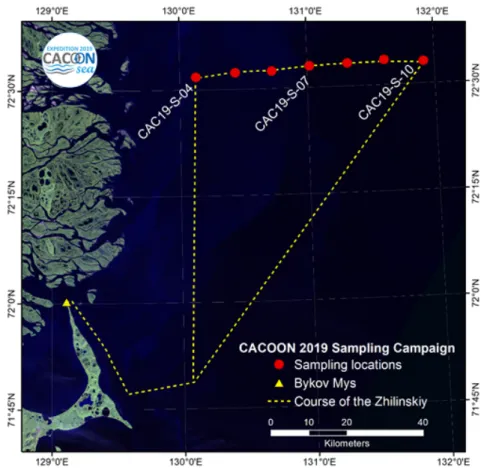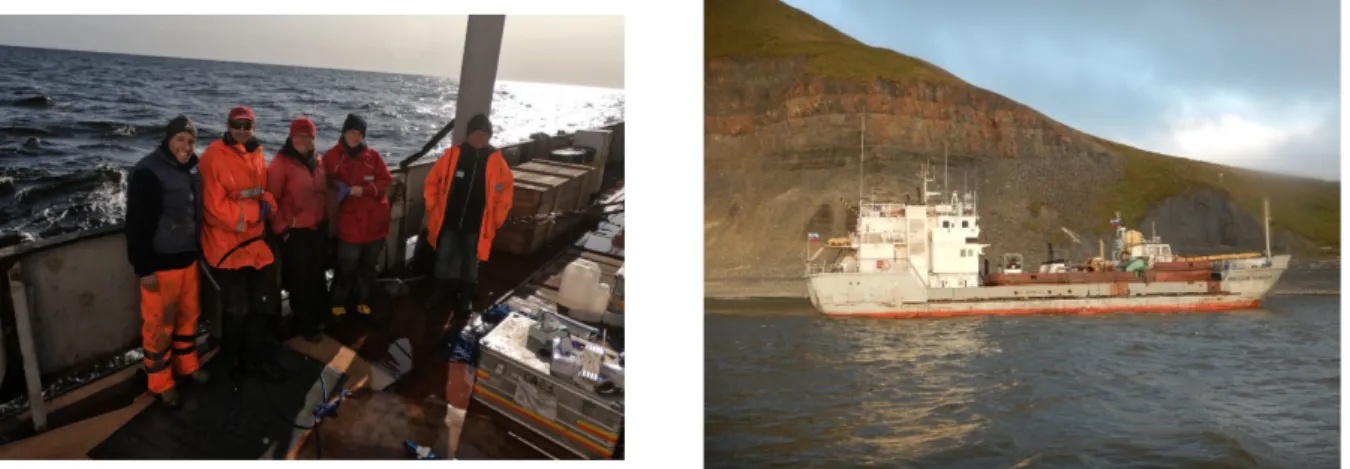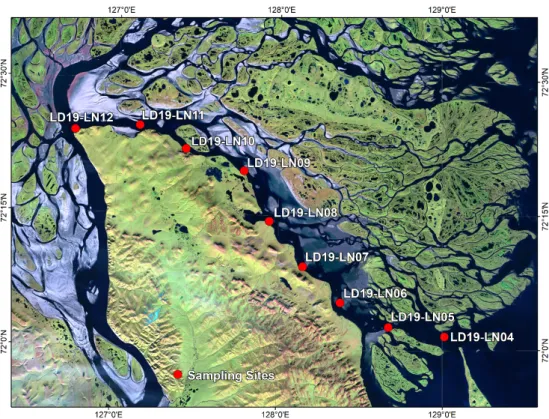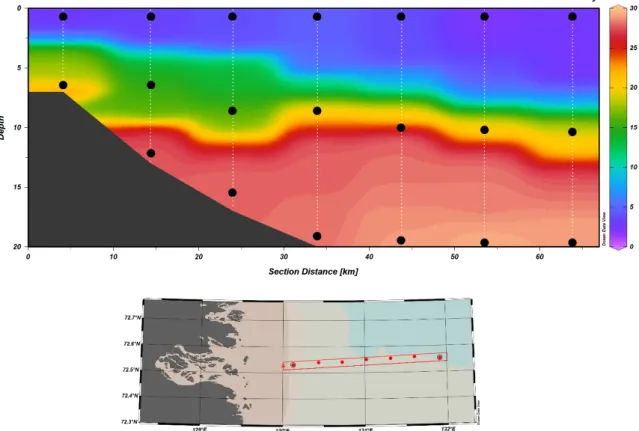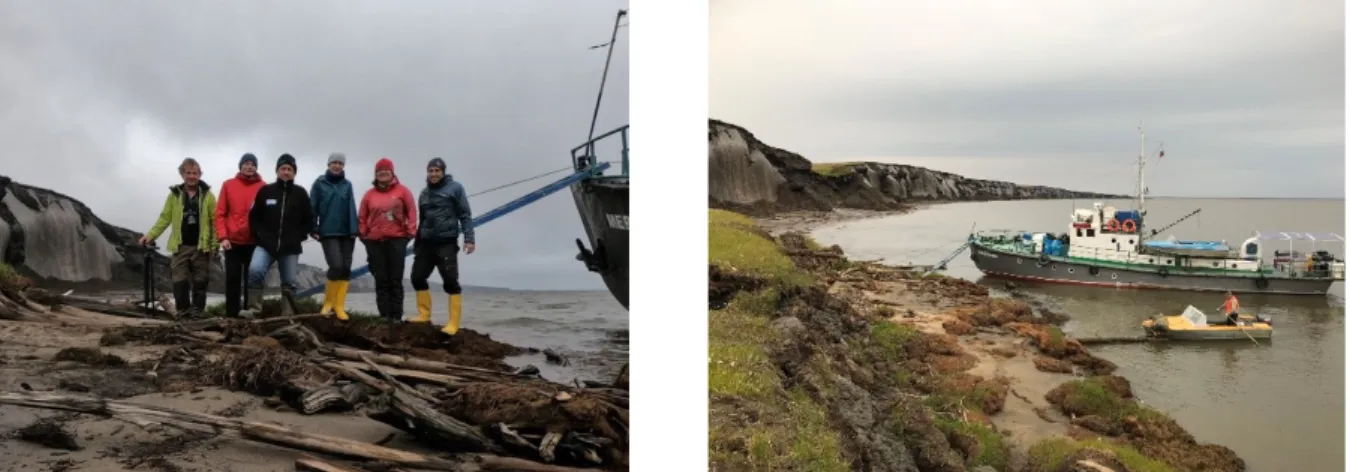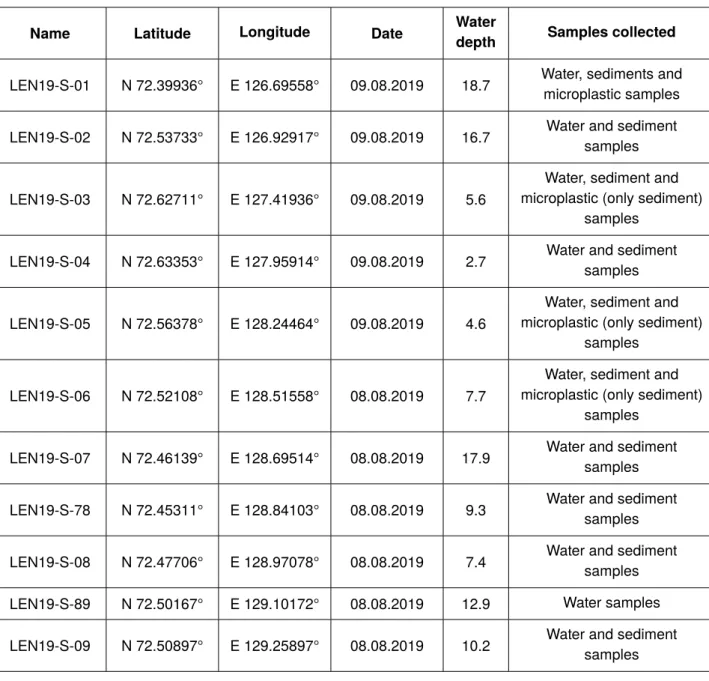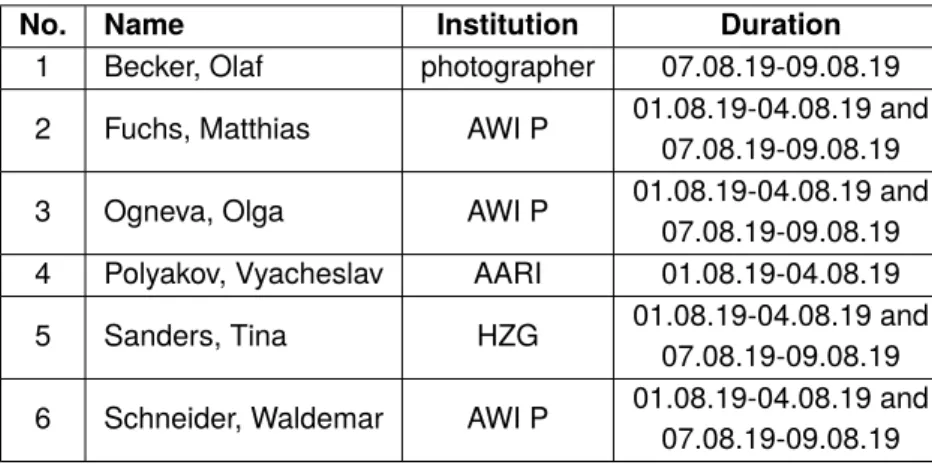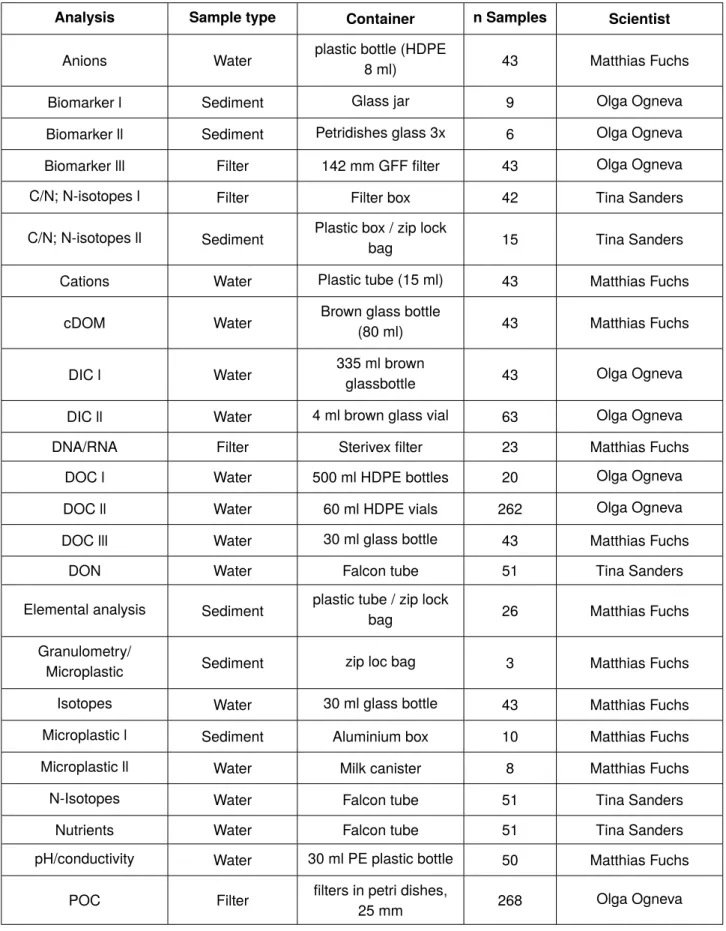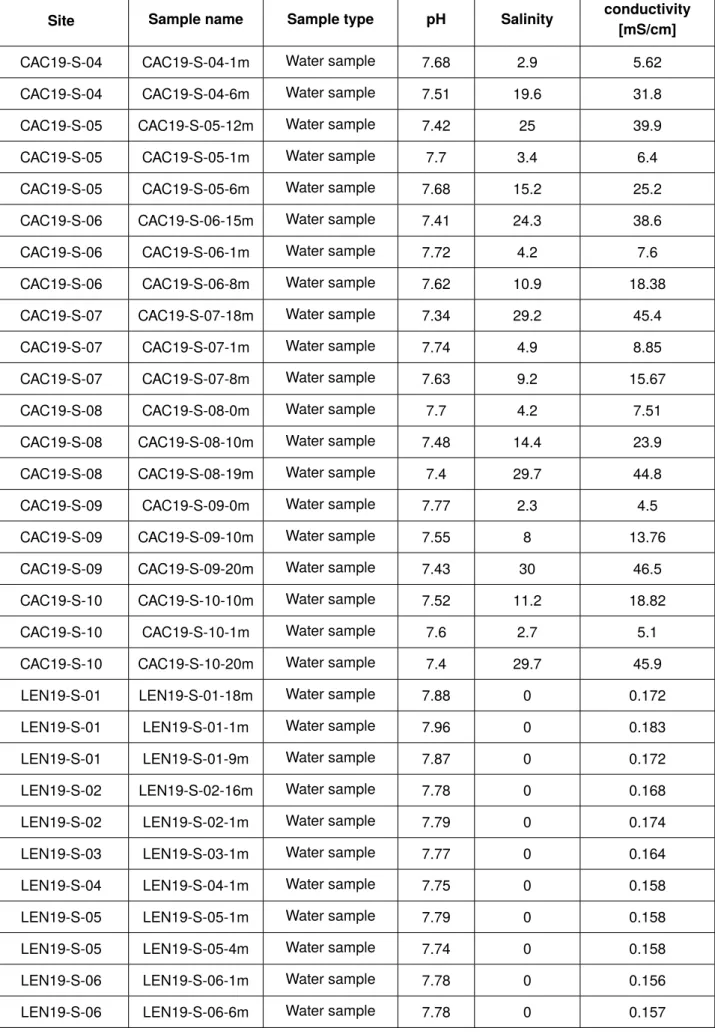Russian-German Cooperation:
Expeditions to Siberia in 2019
Edited by
Matthias Fuchs, Dmitry Bolshiyanov, Mikhail Grigoriev, Anne Morgenstern, Luidmila Pestryakova, Leonid Tsibizov, and Antonia Dill
with contributions of the participants
Berichte
zur Polar- und Meeresforschung
Reports on Polar and Marine Research
749 2021
part of:
3.26 CACOON Sea - water sampling along the Sardakhskaya channel and near shore of the Laptev Sea
Matthias Fuchs1, Olga Ogneva1,2, Tina Sanders3, Waldemar Schneider1, Vyacheslav Polyakov4, Olaf Otto Becker5, (Dmitry Bolshiyanov4, Gesine Mollenhauer2, Jens Strauss1: not in field)
1 Alfred Wegener Institute Helmholtz Centre for Polar and Marine Research, Potsdam, Germany
2 Alfred Wegener Institute Helmholtz Centre for Polar and Marine Research, Bremerhaven, Germany
3 Helmholtz Zentrum Geesthacht, Centre for Materials and Coastal Research, Geesthacht, Germany
4 State Research Center, Arctic and Antarctic Research Institute, St. Petersburg, Russia
5 Free-lance artist and photographer, Munich, Germany
Fieldwork period and location
From July 28thto August 23th, 2019 (on Samoylov Island, Sardakhskaya channel and near-shore Laptev Sea).
Funding
This project was kindly funded by a joint BMBF-NERC’s program “Changing Arctic Ocean” (CACOON-project, NERC grant no. NE/R012806/1, BMBF grant no. 03F0806A, EISPAC-project BMBF grant no. 03F0809A).
Contribution to public outreach
The artist and photographer Olaf Otto Becker will publish a photobook on this expedition. The publishing date is expected to be end of 2020. Moreover, he will contribute pictures and write articles for non-scientific journals with stories from this expedition. Expedition participant Dr. Tina Sanders wrote a blog (in German) on this expedition (
https://blogs.helmholtz.de/kuestenforschung/2019/08/20/rueckkehr-ins-lena- delta-nach-mehr-als-10-jahren/
).Campaigns
This expedition contained three parts. The first part was a sea cruise (Figure 3.26.1) on the Laptev Sea with the vessel Anatoliy Zhilinskiy, the second part was a river cruise on the Sardakhskaya channel with the ship Merzlotovedand the third part included intensive laboratory work on Samoylov Research Station.
Our weekly reports (in German only) are available here:
1.
https://www.awi.de/fileadmin/user_upload/AWI/Forschung/Geowissenschaft/
Periglazialforschung/Bilder_Peri/Stationen/Wochenberichte_Samoylov/
Wochenbericht-1_CACOONsea.pdf
2.
https://www.awi.de/fileadmin/user_upload/AWI/Forschung/Geowissenschaft/
4.
https://www.awi.de/fileadmin/user_upload/AWI/Forschung/Geowissenschaft/
Periglazialforschung/Bilder_Peri/Stationen/Wochenberichte_Samoylov/
Wochenbericht_4_CACOON.pdf
CACOON SEA part 1: Laptev Sea transect Time Period: 02.08.2019 - 04.08.2019
Region: Laptev Sea 20-80 km East of Lena delta (Sardakhskaya channel) (Figure 3.26.1) Vessel: Anatoliy Zhilinskiy(Figure 3.26.2)
Figure 3.26.1:Route of the CACOON Sea expedition on the ship Anatoliy Zhilinskiy
Aim
The aim of the expedition was to investigate the transition from fresh water to salt water and its impact on fate and quality on dissolved and particulate organic and inorganic carbon and nitrogen. This is in accordance with the main Changing Arctic Carbon cycle in the cOastal Ocean Near-shore (CACOON,
https://www.changing-arctic-ocean.ac.uk/project/cacoon/
) project goal to investigate the chang- ing freshwater export and impact of terrestrial permafrost thaw into the near-shore zone of the Laptev Sea.Figure 3.26.2:Left: The expedition team: Matthias Fuchs, Vyacheslav (Slava) Polyakov, Tina Sanders, Olga Ogneva, Waldemar Schneider. Right: The vessel “Anatoliy Zhilinskiy”
Methods
Water samples were collected from three different depths (top, middle, bottom) with a UWITEC water sampler.
Water was filled in 20 L canisters and kept cool for the return transport and processing on Samoylov Island.
Water samples for nutrient analysis including dissolved organic and inorganic nitrogen were done immediately onboard with a syringe filter system (0.45𝜇m). In addition, sediment samples were retrieved with a gravity corer where possible; else a sediment grab was used to get the top 5 cm of the sea floor sediments. Prior to sampling, conductivity, temperature and depth of the water were measured.
Water samples will be filtered in the laboratory and later analyzed for dissolved inorganic carbon, dissolved organic carbon, particulate organic carbon,𝛿13C,Δ14C, biomarkers, cDOM, anions, cations, water isotopes, pH and conductivity/salinity, dissolved inorganic nitrogen, dissolved organic nitrogen, total nitrogen and𝛿15N.
On two locations (CAC19-S-05 and CAC19-S-10) water samples for microplastic analysis were collected with a steal container and a hemp rope. In addition, sediment samples from the top 5 cm were collected with the sediment grab. These samples will be processes and analyzed by M. Bergmann (not in field) at AWI Bremerhaven.
Route
We left Bykov Mys (Figure 3.26.1) on August 2nd, 2019, 06:00 pm and shipped south along Bykovsky Peninsula following the shipping channel. At the southern tip of Bykovsky Peninsula we turned east until we reached the 12 mile zone border. From there we traveled northeast, heading directly to CAC19-S-10 (for coordinates see below in Table 3.26-1). We reached CAC19-S-10 on August 3rd, 2019, 06:30 am and started sampling immediately.
We worked and sampled our way West along the planned transect with a 10 km distance between sample locations until we reached CAC19-S-04. CAC19-S-04 was the last sampling location since location CAC19-S-03 was too shallow to reach with theAnatoliy Zhilinskiy. The return travel was South, until we reached the 12 mile zone, then heading west to the southern tip of Bykovsky Peninsula from where we turned North until we reached Bykov Mys again, which was our final destination with theAnatoliy Zhilinskiyreached on August 4th, 2019, 11:30 am.
On the return travel from Bykovsky Mys to Samoylov Island, water samples were collected on nine different sites along the Bykovskaya channel (Figure 3.26.3, Table 3.26-2) from board of the vesselMerzlotoved.
Figure 3.26.3:Return route from Bykov Mys to Samoylov Island with sampling locations
Sampling locations:
Table 3.26-1: Sampling locations on the Laptev Sea transect
Name Latitude Longitude Date Water
depth Samples collected CAC19-S-04 N 72.53014° E 130.12631° 03.08.2019 6.9 Water (from two depths only)
and sediment with grab
CAC19-S-05 N 72.53928° E 130.43433° 03.08.2019 13.0
Water and sediment core + samples for microplastic
analysis
CAC19-S-06 N 72.54128° E 130.72461° 03.08.2019 16.7 Water and sediment core CAC19-S-07 N 72.55056° E 131.01814° 03.08.2019 19.4 Water and sediment core CAC19-S-08 N 72.55447° E 131.31572° 03.08.2019 20.8 Water and sediment core CAC19-S-09 N 72.55900° E 131.91447° 03.08.2019 21.8 Water and sediment core
CAC19-S-10 N 72.55294° E 131.91447° 03.08.2019 21.6
Water and sediment core + samples for microplastic
analysis
Table 3.26-2: Sampling locations in the Bykovskaya Channel
Name Latitude Longitude Date
Water Temp.
[°C]
Samples collected
LD19-LN4 N 72.02644° E 129.01319° 04.08.2019 14.6 Water samples by bucket LD19-LN5 N 72.04394° E 128.67339° 04.08.2019 14.5 Water samples by bucket LD19-LN6 N 72.08897° E 128.38069° 04.08.2019 14.5 Water samples by bucket LD19-LN7 N 72.15556° E 128.15086° 04.08.2019 14.6 Water samples by bucket LD19-LN8 N 72.23922° E 127.94347° 04.08.2019 14.4 Water samples by bucket LD19-LN9 N 72.33236° E 127.78397° 04.08.2019 14.6 Water samples by bucket LD19-LN10 N 72.37144° E 127.42497° 04.08.2019 14.6 Water samples by bucket LD19-LN11 N 72.41331° E 127.13744° 04.08.2019 14.7 Water samples by bucket LD19-LN12 N 72.40217° E 126.73853° 04.08.2019 14.6 Water samples by bucket
Preliminary results
During the Zhilinskiy cruise we collected 40-60 L of water for each sampling location (ca. 400 L in total).
Sediment cores could be obtained for CAC19-S-05 to CAC19-S-10 with the gravity corer. However, all cores are shorter than 20 cm. For CAC19-S-04 sediments could only be obtained with the sediment grab. Microplastic samples (water + sediment from the top 5 cm) were collected from CAC19-S-05 and CAC19-S-10. First results of pH and conductivity measurements of the water samples show that there is a fresh water inflow from the Sardakhskaya channel into the Laptev Sea indicated by lower conductivity values for the top layer water samples for all seven sample locations (Figure 3.26.4 and Table A.2.15).
During the Merzlozoved passage to Samoylov Island (Figure 3.26.2), samples for measurement of dissolved organic nitrogen (DON) and dissolved inorganic nitrogen (DIN) e.g. ammonium (NH4), nitrite (NO2) and nitrate (NO3), as well as for dual stable isotopes of nitrate (𝛿15N and𝛿18O) were collected. The samples were taken by a bucket, temperatures were measured and the samples were filtered and stored frozen (Table 3.26-2).
Figure 3.26.4:Salinity profile along the transect from CAC19-S-04 (on the left side) to CAC19-S-10 (on the right side). Black dots indicate depths at which water samples have been collected.
CACOON SEA part 2: Sardakhskaya channel transect Time Period: 07.08.2019 - 09.08.2019
Region: Sardakhskaya channel from Stolb Island to the Lena River outlet (Figure 3.26.5) Vessel: Merzlotoved(Figure 3.26.6)
Figure 3.26.5:CACOON sample locations on the Sardakhskaya channel in the Lena River Delta
Aim
Degrading permafrost releases organic carbon and nitrogen to the Lena River and likely transports it to the Arctic Ocean. The CACOON project aim of the Sardakhskaya transect was to investigate the quality and quantity of particulate and dissolved organic carbon and nitrogen during this transport. Also, sample locations from the CACOON Ice expedition (see chapter 2.1) in spring 2019 were resampled to analyze the seasonality in particulate and dissolved organic carbon on its transport to the Laptev Sea.
Methods
The methods were the same like on the CACOON Sea Part 1 expedition. The only exception was that samples were taken from one to three different water depths depending on the depth of the water (Table 3.26-3). Sediment cores could not be retrieved in the Sardakhskaya channel, however sediment samples from each location were collected with the sediment grab. Again, samples were collected for hydrogeochemical, biogeochemical as well as microplastic analyses. Conductivity, depth and temperature (CTD) profiles were measured at each location with a handheld SontekTMCastAway conductivity, temperature, and depth sensor.
Route
The CACOON Crew started with the shipMerzlotoved(Figure 3.26.6) on August 7th, 2019 from Samoylov Island.
During the first day, the cruise went all the way to Sobo-Sise Island and stopped for the night at Sobo-Sise Cliff (Figure 3.26.6). During the following day, the cruise continued and the CACOON team sampled sites on the way back from LEN19-S-09 to LEN19-S-06. For the night, the ship returned to Sobo-Sise Cliff. On the final day the ship traveled back to Samoylov Island sampling the sites LEN19-S-05 to LEN19-S-01. The distance between the sample locations varies. From LEN19-S-01 to LEN19-S-04 the distance is 20 km. Then a shorter distance was chosen (10 km) to sample multiple sample locations from the CACOON Ice expedi- tion. This is also the reason that two additional sites (LEN19-S-78 and LEN19-S-89) were added in 5 km intervals.
Figure 3.26.6:Left: The expedition team: Otto Olaf Becker, Vanja, Waldemar Schneider, Olga Ogneva, Tina Sanders and Matthias Fuchs, right: The vessel Merzlotoved in front of the Sobo-Sise-Cliff
Sampling locations:
Table 3.26-3: Sampling locations on Sardakhskaya transect
Name Latitude Longitude Date Water
depth Samples collected LEN19-S-01 N 72.39936° E 126.69558° 09.08.2019 18.7 Water, sediments and
microplastic samples LEN19-S-02 N 72.53733° E 126.92917° 09.08.2019 16.7 Water and sediment
samples
LEN19-S-03 N 72.62711° E 127.41936° 09.08.2019 5.6
Water, sediment and microplastic (only sediment)
samples LEN19-S-04 N 72.63353° E 127.95914° 09.08.2019 2.7 Water and sediment
samples
LEN19-S-05 N 72.56378° E 128.24464° 09.08.2019 4.6
Water, sediment and microplastic (only sediment)
samples
LEN19-S-06 N 72.52108° E 128.51558° 08.08.2019 7.7
Water, sediment and microplastic (only sediment)
samples LEN19-S-07 N 72.46139° E 128.69514° 08.08.2019 17.9 Water and sediment
samples LEN19-S-78 N 72.45311° E 128.84103° 08.08.2019 9.3 Water and sediment
samples LEN19-S-08 N 72.47706° E 128.97078° 08.08.2019 7.4 Water and sediment
samples LEN19-S-89 N 72.50167° E 129.10172° 08.08.2019 12.9 Water samples LEN19-S-09 N 72.50897° E 129.25897° 08.08.2019 10.2 Water and sediment
samples
Preliminary results
During the Sardakhskaya channel cruise, we sampled water and sediment at eleven different sites and collected ca. 460 liters of water. Sediment samples could be obtained with the sediment grab from all locations except LEN19-S-89. In general, the sediment was predominately sandy. First results of pH and conductivity measurements of the water samples show that there are only small variations in pH and conductivity throughout the entire Sardakhskaya channel (Table A.2.15).
CACOON SEA part 3: Samoylov Research Station - summary Time Period: 10.08.2019 - 28.08.2019
Region: Samoylov Research Station Aim
The aim of this third and last part of the CACOON Sea expedition was to subsample the collected water samples for the different planned analyzes and to prepare the samples for the transport.
Methods
The water samples were subsampled in different ways depending on the planned analyses (Table A.2.14). Water samples were filtered at Samoylov Research Station laboratory. The DOC and cDOM samples were filtered with a GF/F 0.71𝜇m filter, whereas the anions and cations samples were filtered with a 0.45 𝜇m pore size filter. In addition, larger GF/F filters with a 25 mm diameter for POC analysis were stored frozen in pre-combusted glass petri dishes and GF/F filteres with a 114 mm diameter for biomarker analyzes were stored in pre-combusted aluminum envelope. The latter were frozen for safe transportation. For preservation, DOC samples were acidified with HCl and cations samples were acidified with HNO3. In addition, 0.5 l of water was filtered through Sterivex filter units for aquatic microbial analysis.
For the DIN, DON and nitrate stable isotope analysis, water samples were filtered onboard and stored at -18°C.
For element analysis of the suspended matter (SPM) water samples were filtered through pre-combusted GF/F filters (4 hrs, 450°C). Filter samples were dried at 50°C and stored frozen. The filters will be used for total nitrogen and organic carbon analysis as well as 𝛿15N of SPM. All sediments as well as all the microplastic samples were stored and transported frozen.
Preliminary results
In total, the CACOON Sea expedition collected nearly ca. 30 kg of sediment and 900 liters of water, which were later (on Samoylov Research Station) subsampled into ca. 1350 different sub-samples (Table A.2.14). In combination with the CACOON Ice expedition (see chapter 2.1) a transect of 200 km beginning from Stolb Island passing trough the entire Sardakhskaya channel and as far as 80 km into the Laptev Sea could be sampled.
This allows us to analyze the transformation of organic carbon from degrading permafrost on its way to the Arctic Ocean.
Acknowledgements
We thank the captain and crew of theAnatoliy Zhilinskiyand theMerzlotovedfor hosting us, as well as the staff and crew of Samoylov Research Station for logistic support during the laboratory analyses. We thank the AARI St. Petersburg (D. Bolshiyanov) for help with organization, Volkmar Aßmann for logistic support and the NERC and BMBF for funding our project.
Table A.1.4: List of participants in CACOON summer expedition
No. Name Institution Duration
1 Becker, Olaf photographer 07.08.19-09.08.19 2 Fuchs, Matthias AWI P 01.08.19-04.08.19 and
07.08.19-09.08.19 3 Ogneva, Olga AWI P 01.08.19-04.08.19 and
07.08.19-09.08.19 4 Polyakov, Vyacheslav AARI 01.08.19-04.08.19
5 Sanders, Tina HZG 01.08.19-04.08.19 and
07.08.19-09.08.19 6 Schneider, Waldemar AWI P 01.08.19-04.08.19 and
07.08.19-09.08.19
Tables from 3.26.
Table A.2.14: Summary of the collected samples on the CACOON Sea Expedition 2019
Analysis Sample type Container n Samples Scientist
Anions Water plastic bottle (HDPE
8 ml) 43 Matthias Fuchs
Biomarker l Sediment Glass jar 9 Olga Ogneva
Biomarker ll Sediment Petridishes glass 3x 6 Olga Ogneva
Biomarker lll Filter 142 mm GFF filter 43 Olga Ogneva
C/N; N-isotopes l Filter Filter box 42 Tina Sanders
C/N; N-isotopes ll Sediment Plastic box / zip lock
bag 15 Tina Sanders
Cations Water Plastic tube (15 ml) 43 Matthias Fuchs
cDOM Water Brown glass bottle
(80 ml) 43 Matthias Fuchs
DIC l Water 335 ml brown
glassbottle 43 Olga Ogneva
DIC ll Water 4 ml brown glass vial 63 Olga Ogneva
DNA/RNA Filter Sterivex filter 23 Matthias Fuchs
DOC l Water 500 ml HDPE bottles 20 Olga Ogneva
DOC ll Water 60 ml HDPE vials 262 Olga Ogneva
DOC lll Water 30 ml glass bottle 43 Matthias Fuchs
DON Water Falcon tube 51 Tina Sanders
Elemental analysis Sediment plastic tube / zip lock
bag 26 Matthias Fuchs
Granulometry/
Microplastic Sediment zip loc bag 3 Matthias Fuchs
Isotopes Water 30 ml glass bottle 43 Matthias Fuchs
Microplastic l Sediment Aluminium box 10 Matthias Fuchs
Microplastic ll Water Milk canister 8 Matthias Fuchs
N-Isotopes Water Falcon tube 51 Tina Sanders
Total N Water Falcon tube 51 Tina Sanders
Backup Water 30 ml PE plastic bottle 43 Matthias Fuchs
AARI St. Petersburg Sediment core plastic tube 6 Slava Polyakov
Table A.2.15: pH, salinity and conductivity measurements on the CACOON Sea expedition
Site Sample name Sample type pH Salinity conductivity
[mS/cm]
CAC19-S-04 CAC19-S-04-1m Water sample 7.68 2.9 5.62
CAC19-S-04 CAC19-S-04-6m Water sample 7.51 19.6 31.8
CAC19-S-05 CAC19-S-05-12m Water sample 7.42 25 39.9
CAC19-S-05 CAC19-S-05-1m Water sample 7.7 3.4 6.4
CAC19-S-05 CAC19-S-05-6m Water sample 7.68 15.2 25.2
CAC19-S-06 CAC19-S-06-15m Water sample 7.41 24.3 38.6
CAC19-S-06 CAC19-S-06-1m Water sample 7.72 4.2 7.6
CAC19-S-06 CAC19-S-06-8m Water sample 7.62 10.9 18.38
CAC19-S-07 CAC19-S-07-18m Water sample 7.34 29.2 45.4
CAC19-S-07 CAC19-S-07-1m Water sample 7.74 4.9 8.85
CAC19-S-07 CAC19-S-07-8m Water sample 7.63 9.2 15.67
CAC19-S-08 CAC19-S-08-0m Water sample 7.7 4.2 7.51
CAC19-S-08 CAC19-S-08-10m Water sample 7.48 14.4 23.9
CAC19-S-08 CAC19-S-08-19m Water sample 7.4 29.7 44.8
CAC19-S-09 CAC19-S-09-0m Water sample 7.77 2.3 4.5
CAC19-S-09 CAC19-S-09-10m Water sample 7.55 8 13.76
CAC19-S-09 CAC19-S-09-20m Water sample 7.43 30 46.5
CAC19-S-10 CAC19-S-10-10m Water sample 7.52 11.2 18.82
CAC19-S-10 CAC19-S-10-1m Water sample 7.6 2.7 5.1
CAC19-S-10 CAC19-S-10-20m Water sample 7.4 29.7 45.9
LEN19-S-01 LEN19-S-01-18m Water sample 7.88 0 0.172
LEN19-S-01 LEN19-S-01-1m Water sample 7.96 0 0.183
LEN19-S-01 LEN19-S-01-9m Water sample 7.87 0 0.172
LEN19-S-02 LEN19-S-02-16m Water sample 7.78 0 0.168
LEN19-S-02 LEN19-S-02-1m Water sample 7.79 0 0.174
LEN19-S-03 LEN19-S-03-1m Water sample 7.77 0 0.164
LEN19-S-07 LEN19-S-07-15m Water sample 7.92 0 0.155
LEN19-S-07 LEN19-S-07-1m Water sample 7.8 0 0.159
LEN19-S-08 LEN19-S-08-1m Water sample 7.71 0 0.156
LEN19-S-08 LEN19-S-08-6m Water sample 7.77 0 0.156
LEN19-S-09 LEN19-S-09-10m Water sample 7.78 0 0.157
LEN19-S-09 LEN19-S-09-1m Water sample 7.8 0 0.158
LEN19-S-09 LEN19-S-09-5m Water sample 7.81 0 0.157
LEN19-S-78 LEN19-S-78-1m Water sample 7.84 0 0.156
LEN19-S-78 LEN19-S-78-8m Water sample 7.8 0 0.155
LEN19-S-89 LEN19-S-89-12m Water sample 7.8 0 0.157
LEN19-S-89 LEN19-S-89-1m Water sample 7.73 0 0.159
LEN19-S-89 LEN19-S-89-6m Water sample 7.77 0 0.157
749 (2021) Russian-German Cooperation: Expeditions to Siberia in 2019, edited by Matthias Fuchs, Dmitry Bolshiyanov, Mikhail Grigoriev, Anne Morgenstern, Luidmila Pestryakova, Leonid Tsibizov, and Antonia Dill
748 (2020) Das Alfred-Wegener-Institut in der Geschichte der Polarforschung: Einführung und Chronik, 2., erweiterte und überarbeitete Auflage, von Christian R. Salewski, Reinhard A. Krause, Elias Angele
747 (2020) Reconstruction of paleo sea ice and climate dynamics based on highly branched isopre- noids at the Western Antarctic Peninsula, by Maria-Elena Vorrath
746 (2020) Deutsche Südpolar-Expedition 1901-1903 Sport Kleidung und Ausrüstung für Schlitten- reisen, herausgegeben von Cornelia Lüdecke, basierend auf einem Manuskript von Hans Gazert, Beiträgen von Expeditionsteilnehmern und anderen Zeitgenossen
745 (2020) Expeditions to Antarctica: ANT-Land 2019/20 Neumayer Station III, Kohnen Station, Flight Operations and Field Campaigns, edited by Tanja Fromm, Constance Oberdieck, Thomas Matz, Christine Wesche
744 (2020) The Expedition AF122/1 Setting up the MOSAiC Distributed Network in October 2019 with Research Vessel AKADEMIK FEDOROV, edited by Thomas Krumpen and Vladimir Sokolov
743 (2020) The Expedition to the Peel River in 2019: Fluvial Transport Across a Permafrost Land- scape, edited by Frederieke Miesner, P. Paul Overduin, Kirsi Keskitalo, Niek J. Speetjens, Jorien Vonk, Sebastian Westermann
742 (2020) Das Alfred-Wegener-Institut in der Geschichte der Polarforschung: Einführung und Chronik, von Christian R. Salewski, Reinhard A. Krause, Elias Angele
Band 569 (2008) als Open-Access-Publikati- on herausgegeben. Ein Verzeichnis aller Bände einschließlich der Druckausgaben (ISSN 1618- 3193, Band 377-568, von 2000 bis 2008) sowie der früheren Berichte zur Polarforschung (ISSN 0176-5027, Band 1-376, von 1981 bis 2000) befindet sich im electronic Publication In- formation Center (ePIC) des Alfred-Wegener-Ins- tituts, Helmholtz-Zentrum für Polar- und Meeres- forschung (AWI); see https://epic.awi.de. Durch Auswahl “Reports on Polar- and Marine Re- search“ (via “browse”/”type”) wird eine Liste der Publikationen, sortiert nach Bandnummer, inner- halb der absteigenden chronologischen Reihen- folge der Jahrgänge mit Verweis auf das jeweili- ge pdf-Symbol zum Herunterladen angezeigt.
Zuletzt erschienene Ausgaben:
publications since 2008. A table of all volumes in- cluding the printed issues (ISSN 1618-3193, Vol.
377-568, from 2000 until 2008), as well as the earlier Reports on Polar Research (ISSN 0176- 5027, Vol. 1-376, from 1981 until 2000) is pro- vided by the electronic Publication Information Center (ePIC) of the Alfred Wegener Institute, Helmholtz Centre for Polar and Marine Research (AWI); see URL https://epic.awi.de. To generate a list of all Reports, use the URL http://epic.awi.de and select “browse”/ ”type” to browse ”Reports on Polar and Marine Research”. A chronological list in declining order will be presented, and pdf- icons displayed for downloading.
Recently published issues:
